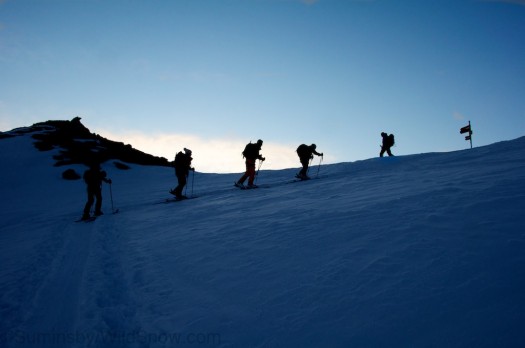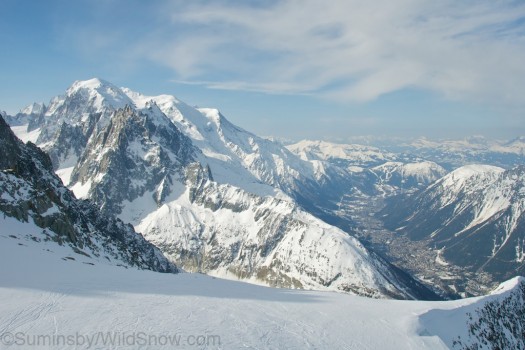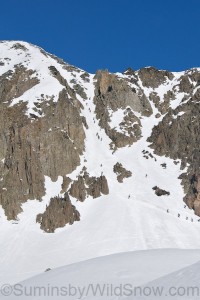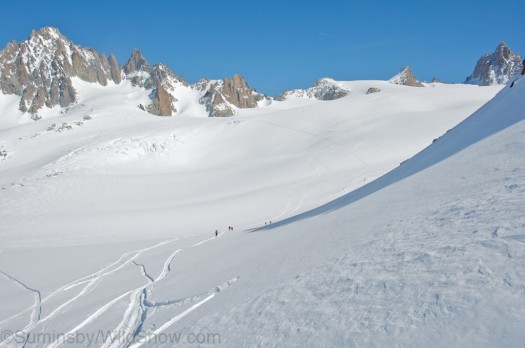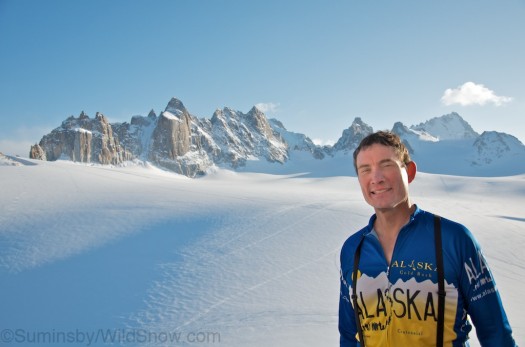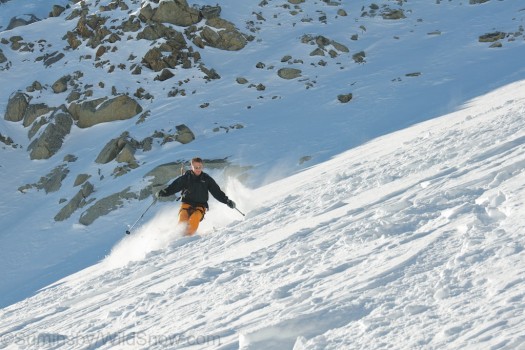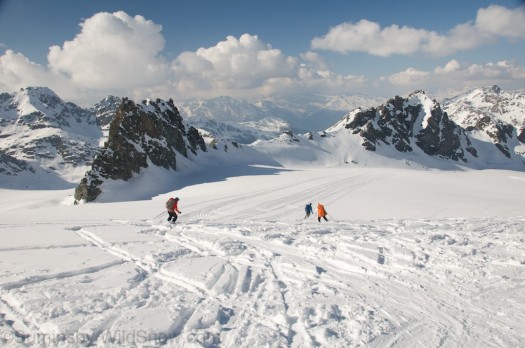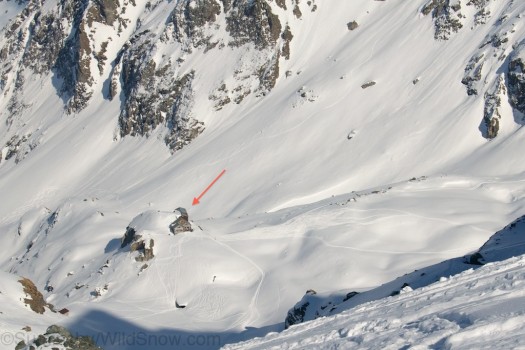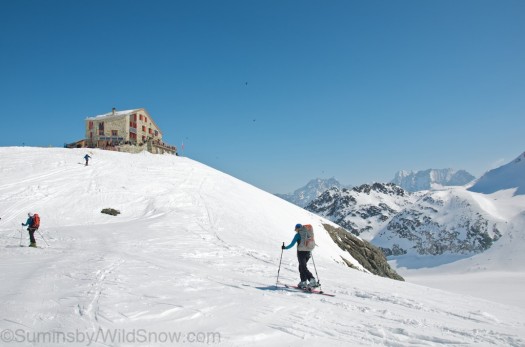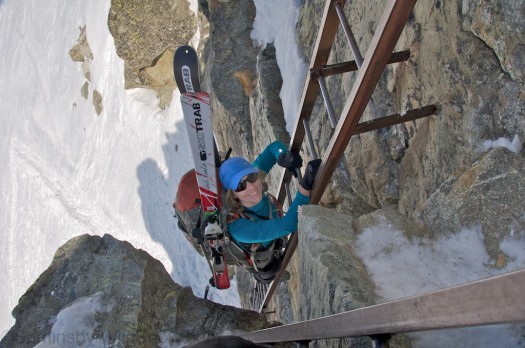Robert Suminsby
(Editor’s note: This trip report came in a few days ago and we liked the story for those of you who have never done a European hut trip — so here you go.)
There I was: four days into a five-day ski tour of the famous Haute Route linking Chamonix and Zermatt. Relaxing in the octagon dining area of the spectacular Bertol Hut, I spent a few minutes thumbing through the Hüttenbuch (the hut’s visitor log), mystified that so few Americans had marked their passage through this amazing spot. Plenty of Swiss, of course, and ample numbers of French, German, and assorted other Euro-types, but the letters “USA” were in short supply. (Colorado, it must be said, had the lion’s share of the few American entries I found.)
With the explosion of interest in backcountry skiing, why had so few of my countrymen made the journey to one of the most famous huts in the Alps? Yes, we have plenty of terrain to explore in the US, and getting oneself and a big pile of gear to the other side of an ocean is a daunting prospect. Still, this is the Alps: the birthplace of alpinism, the ancestral home of ski touring. Surely, there must be lots of Americans dreaming of these distant mountains?
Or maybe not. It occurred to me that perhaps the Haute Route isn’t as well known back home as it is here in Europe. Or worse, Americans may have heard of it but written it off as too much of a logistical hassle, a mysterious Holy Grail of ski touring that would remain forever out of reach.
If all that describes you, then don’t despair. Read on.
Admittedly, getting to the Alps was relatively easy for me since I’ve had the good fortune to spend the past four years living in Germany, within easy striking distance of places like Chamonix. I’ve visited there many times, and it does not take me long to settle in and feel right at home. For those who haven’t yet made the pilgrimage to that mecca of mountain adventures, I hope the tips I pass on here will bring you a step or two closer to tackling this tour.
The first question to confront is whether to sign on with a guided tour, or strike out on your own. Although I’ve been skiing all my life, I only began ski touring last season, and prior to the Haute Route I only had a grand total of six days on skins. So this decision was an easy one for me; I signed up with a UK-based mountaineering guide service.
If you have never done any ski touring in the Alps, I would recommend doing the same, at least for your first trip. Having a guide offers numerous advantages: you’ll be getting the benefit of local knowledge of terrain and weather conditions, you’ll have someone proficient in the art of crevasse rescue, and someone to carry the rope. While you might be able to plan and execute the Haute Route on your own, you’ll definitely be at a disadvantage if weather forces you to change your itinerary, or retreat to a valley along the way.
By hiring a guide, you’re also getting the services of a mountain concierge. The huts will be booked for you. If plans change, the guide will likely have the usual huts programmed into his cell phone. And, you’ll have someone who can negotiate with the hut keeper in at least passable French, German, and Italian. Our tour company had engaged the services of Stephano, a capable and personable Italian, and a veteran of many years of touring in these mountains.
Of course, you’ll need to get yourself to Chamonix, and that’s not as hard as you might think. Fly into Geneva (probably connecting through Paris, London, or one of the other major European hubs). From there you can catch one of several shuttle bus transfers to Chamonix (about an hour and a half, €30 each way). If you haven’t been spending a lot of time in high mountains, treat yourself to an extra day or two in Chamonix on the front end of the trip, to help acclimatize and get over jet lag. You’ll be glad you did. Chamonix is a fun town, with an eclectic mix of all nationalities. English is spoken virtually everywhere, so even a mono-lingual American can get by with ease. The steeps around Chamonix are legendary, and if you come this far, you’ll want some extra time to enjoy them.
The typical itinerary for the Haute Route is five to six days, and the choice of which huts to stay in along the route varies. A tour company for guided groups will probably have several contingency options if you aren’t able to reach your planned destination on a given night, or if you are forced to retreat due to poor weather. Our planned route was the popular “Verbier variation,” which uses the lifts at the Swiss resort to save some time gaining vertical.
Our group consisted of six clients (four Brits and two Americans), plus our guide. None of us, except Stephano, were highly experienced with ski touring, but we had at least some previous exposure. Fitness, as opposed to technical ability, is the primary requirement.
Day 1: Les Grand Montets to Trient Hut
The Haute Route begins, typically, at the Les Grand Montets cable car near the village of Argentiere, just east of Chamonix. This lift is almost always crowded early in the morning, so patience is advised. Tricked out with a full pack, ice axe, and climbing harness, we could at least feel we were a rung or two up the ladder from the rest of the rabble (hint, pack your sharps so you don’t damage someone on the closely packed cable car, and know that reservations are available if you want to not wait in line forever during a crowded time). From the top of the cable car (weather permitting), you’ll be treated to some sweeping views of the Chamonix Valley and Mont Blanc.
After a short descent and crossing of the Argentiere Glacier, you’re on your way, ascending either the Col de Passon or the Col de Chardonnay, depending on snow conditions. This close to Chamonix you can expect a lot of company from skiers out for a day tour.
We ascended the Col de Passon, bootpacking the last section along with a throng of other skiers.
Fortunately, we soon enjoyed relative solitude as we headed out across the vast expanse of the Glacier du Tour. Throughout the week, you repeat this same experience…reaching a high col and peering down onto yet another isolated valley or enormous glacier.
The feeling you get at moments like this is, fundamentally, the reason why you should do the Haute Route — the chance to travel through some of the most spectacular mountain terrain in the Alps.
The first day’s travel ended with first a long, long traverse of the Plateau du Trient, followed by a soul-crushing 30-minute skin up to our destination, Trient Hut. When you arrive at last, you quickly forget the end-of-day exertion, because the views from the hut are simply stunning.
We dried our bootliners in the sun, enjoyed the view, and sipped expensive bottles of water (10 Swiss Franc for 1.5L! Budget accordingly.) We settled our gear into our bunks, needing only a sleeping bag liner, as the hut provides blankets or duvet covers. Some of the huts can be chilly…there is typically a fire in the central area at dinner, but don’t expect a roaring blaze at 3 PM. Your puffy jacket will be welcome during late afternoons at the huts, and it’s nice to have a bulky pair of socks to throw on as well. All the huts provide Crocs or similar footwear… you don’t want to be the ugly American tromping around in ski boots.
At 7 PM we sat down for the typical hut dinner: three courses of simple but hearty food. Drinks must be purchased. Beer, wine, sodas and water are all available. The wine list at a typical hut isn’t exactly extensive, but the fact there is a choice at all should remind you how amazing it is to have these refuges sprinkled all across the Alps. We relaxed over beers, peppering Stephano with questions.
Day 2: Treint Hut to Praflueri Hut
The next morning, we scarfed down the usual breakfast of cold cereal and coffee or tea (in some cases, cold cuts and cheese as well; always a welcome addition), grabbed our packs, and headed out the door. After all, we had to catch a cab. Well, not a cab, really, but a ski taxi that would be waiting for us in Champex, to whisk us across the already snowless valley to the Le Châble lift station below Verbier. But first, a careful descent down the upper reaches of the Glacier du Trient, and then another steep bootpack (Stephano elected to have us rope up for this) to reach the col at the head of the Val d’ Arpette, a 3 kilometer-long, northeasterly facing valley that served up some of the best snow of the whole trip. We reached the pistes at Champex with big smiles on our faces, and met our taxi right on time.
Thirty minutes later we were dropped amidst the hustle and bustle of a Saturday at Verbier, one of Switzerland’s largest and most popular resorts. As luck would have it, that Saturday Verbier was also hosting the Freeride World Tour. After a long wait for the Mont Fort cable car, and snaking our way through an enormous crowd of fans while trying not to impale anyone with an ice axe, we traversed down to a spot just below the steep face where the competition was taking place. While the crowds across the valley watched through binoculars or on the Jumbotron, we had a grandstand seat as we ate a snack and put on our skins.
After a half hour of skinning under a blue sky, we had left the resort behind and were back in the wilds of the Alps. Distances and elevations can be deceiving in this landscape where so much of the ski terrain is above treeline. Cols that seem impossibly distant are soon within reach, only to reveal another distant objective. By mid-afternoon we were nearing the 3000m level for the first time in the tour, topping out onto a huge plateau that sloped gently away to the north, in the direction of the Prafleuri Hut, our destination for the second night.
Unlike the Trient Hut, it was all downhill to Prafleuri, a welcome change from the day before.
Sadly, the sun had dropped below the mountaintops before we’d barely had a chance to heave off our packs, so we missed the opportunity to bask in the afternoon sun on the patio.
Day 3: Prafleuri to Arolla
The route east from Prafleuri called for a traverse around a large lake, skirting slopes where the avalanche hazard would rise considerably as the day wore on. So it was an early start, attaching skins by headlamp, and heading up the Col des Roux.
Picking our way through avalanche debris, we began the long traverse, grateful that the hard-packed track allowed us to glide along with only minimal poling. After several kilometers, we left the lake behind, beginning our ascent towards the Dix Hut. Some parties elect to overnight here, but we were pressing on to the next valley. Nonetheless, we voted to make the 20-minute climb up the skin track to the hut to have a cappuccino before continuing. Such luxuries may seem foreign to Americans accustomed to more remote backcountry, but we willingly yielded to temptation.
Stoked with caffeine, we moved on to the Pas de Chevres, a sheer rock wall with fixed ladders up the face. Several parties had arrived here at once, creating a minor gaggle as everyone jockeyed for position. We could have skipped the coffee and beaten the rush, but no one complained. With fair weather, we were in no hurry.
Atop the Pas de Chevres, we could savor the thought of an 800m descent to the isolated town of Arolla, where we could look forward to a night in a hotel — with hot showers. After just two nights in huts, I have to admit that when I entered our room for the night, which contained two sets of bunk beds and a small sink, the first thought to enter my mind was “Wow….we have running water IN OUR ROOM!”
(WildSnow.com guest blogger Rob Suminsby is a recently retired U.S. Air Force officer who has been skiing for over four decades. When Rob had to give up flying F-15s, he eventually turned to off-piste skiing, and eventually ski touring, to get his thrills. For the past four years he has lived in Germany, and traveled over much of the Alps in search of untracked snow. He will soon be moving to New Mexico with his wife, two sons, and a Basset Hound named Buddy.)
To be continued: part 2 will be posted shortly.
Beyond our regular guest bloggers who have their own profiles, some of our one-timers end up being categorized under this generic profile. Once they do a few posts, we build a category. In any case, we sure appreciate ALL the WildSnow guest bloggers!

